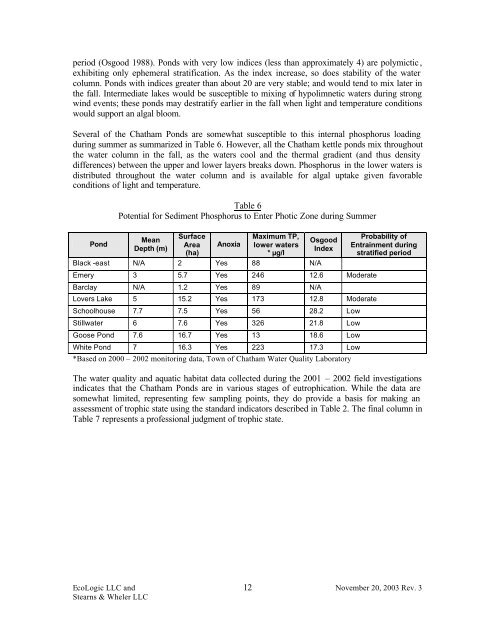Action Plan for the Town of Chatham Ponds
rev 3a report.pdf - Town to Chatham
rev 3a report.pdf - Town to Chatham
You also want an ePaper? Increase the reach of your titles
YUMPU automatically turns print PDFs into web optimized ePapers that Google loves.
period (Osgood 1988). <strong>Ponds</strong> with very low indices (less than approximately 4) are polymictic ,<br />
exhibiting only ephemeral stratification. As <strong>the</strong> index increase, so does stability <strong>of</strong> <strong>the</strong> water<br />
column. <strong>Ponds</strong> with indices greater than about 20 are very stable; and would tend to mix later in<br />
<strong>the</strong> fall. Intermediate lakes would be susceptible to mixing <strong>of</strong> hypolimnetic waters during strong<br />
wind events; <strong>the</strong>se ponds may destratify earlier in <strong>the</strong> fall when light and temperature conditions<br />
would support an algal bloom.<br />
Several <strong>of</strong> <strong>the</strong> <strong>Chatham</strong> <strong>Ponds</strong> are somewhat susceptible to this internal phosphorus loading<br />
during summer as summarized in Table 6. However, all <strong>the</strong> <strong>Chatham</strong> kettle ponds mix throughout<br />
<strong>the</strong> water column in <strong>the</strong> fall, as <strong>the</strong> waters cool and <strong>the</strong> <strong>the</strong>rmal gradient (and thus density<br />
differences) between <strong>the</strong> upper and lower layers breaks down. Phosphorus in <strong>the</strong> lower waters is<br />
distributed throughout <strong>the</strong> water column and is available <strong>for</strong> algal uptake given favorable<br />
conditions <strong>of</strong> light and temperature.<br />
Table 6<br />
Potential <strong>for</strong> Sediment Phosphorus to Enter Photic Zone during Summer<br />
Pond<br />
Mean<br />
Depth (m)<br />
Surface<br />
Area<br />
(ha)<br />
Anoxia<br />
Maximum TP,<br />
lower waters<br />
* µg/l<br />
Black -east N/A 2 Yes 88 N/A<br />
Osgood<br />
Index<br />
Probability <strong>of</strong><br />
Entrainment during<br />
stratified period<br />
Emery 3 5.7 Yes 246 12.6 Moderate<br />
Barclay N/A 1.2 Yes 89 N/A<br />
Lovers Lake 5 15.2 Yes 173 12.8 Moderate<br />
Schoolhouse 7.7 7.5 Yes 56 28.2 Low<br />
Stillwater 6 7.6 Yes 326 21.8 Low<br />
Goose Pond 7.6 16.7 Yes 13 18.6 Low<br />
White Pond 7 16.3 Yes 223 17.3 Low<br />
*Based on 2000 – 2002 monitoring data, <strong>Town</strong> <strong>of</strong> <strong>Chatham</strong> Water Quality Laboratory<br />
The water quality and aquatic habitat data collected during <strong>the</strong> 2001 – 2002 field investigations<br />
indicates that <strong>the</strong> <strong>Chatham</strong> <strong>Ponds</strong> are in various stages <strong>of</strong> eutrophication. While <strong>the</strong> data are<br />
somewhat limited, representing few sampling points, <strong>the</strong>y do provide a basis <strong>for</strong> making an<br />
assessment <strong>of</strong> trophic state using <strong>the</strong> standard indicators described in Table 2. The final column in<br />
Table 7 represents a pr<strong>of</strong>essional judgment <strong>of</strong> trophic state.<br />
EcoLogic LLC and 12<br />
November 20, 2003 Rev. 3<br />
Stearns & Wheler LLC
















